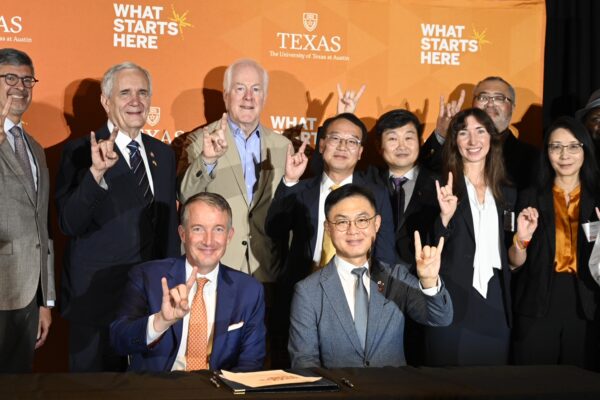AUSTIN, Texas — Samsung Austin Semiconductor and The University of Texas at Austin are partnering to develop the talent pipeline to support the growing semiconductor ecosystem in Central Texas.
Announced as part of Semiconductor Day at UT, the partnership includes funds for recruiting and supporting undergraduate and graduate students to study semiconductor manufacturing in the Cockrell School of Engineering and other key majors across UT, as well as research and development support and upgrades to lab facilities. The partnership will elevate UT’s semiconductor education, innovation and research and position the state as a leader in the burgeoning U.S. semiconductor industry.
“UT Austin’s leadership in America’s semiconductor industry and our role in Austin’s emergence as an industry hub date back to the 1980s,” said UT President Jay Hartzell. “Our Legislature’s bold investment in the CHIPS Act is positioning UT to design and build the future of semiconductors, and now our partnership with Samsung enables us to educate the workforce, fundamental to bolstering the U.S. supply chain. We could not be more excited to work with Samsung to help achieve this important goal.”
Samsung Austin Semiconductor is contributing $1 million to the Cockrell School, a perennial top-10 engineering school, as part of its 5-star workforce development plan. The national Samsung Semiconductor group is contributing an additional $2.7 million to the Cockrell School, with an emphasis on research and development.
Initially, the plan includes scholarships for 40 undergraduate students and fellowships for 10 graduate students, in addition to curriculum support for capstone projects and other student work. These students will also have the opportunity to participate in the company’s paid internship program. Funding to help modernize the undergraduate teaching Fab Lab will expand the number of students trained.
“This partnership opens new doors for our student engineers through hands-on learning experiences and invaluable workforce connections,” said Roger Bonnecaze, dean of the Cockrell School. “It also supports Cockrell researchers who are spearheading semiconductor innovation. We are deeply grateful and excited about the legacy this partnership will leave on the Cockrell School.”
According to a July report by the Semiconductor Industry Association, the industry’s workforce will grow by nearly 115,000 jobs by 2030. However, due to national degree completion rates in related disciplines, approximately 67,000 of these new jobs are at risk of going unfilled — 27,300 of which are for engineers.
“Being able to pull from a skilled and large workforce is of utmost importance for us,” said Samsung Austin Semiconductor President Bonyoung Koo. “That is why we’re investing in a neighboring, top-ranking engineering school such as the Cockrell School.”
Samsung first established a presence in Austin in 1996 and since then has developed close ties to UT. Samsung has hired hundreds of UT alumni and provided internship opportunities for hundreds more. UT students regularly visit and tour the manufacturing campus as part of various student groups.
This partnership formalizes the relationship and sets up a future for developing the next generation of semiconductor leaders.
“This is just the beginning of our shared goal of growing the critically important semiconductor workforce of the future,” Bonnecaze said. “Together, Samsung Semiconductor and the Cockrell School will cement Austin’s reputation as the leader in semiconductor education, research and manufacturing while furthering our goal of being the highest-impact public engineering school in the world.”




